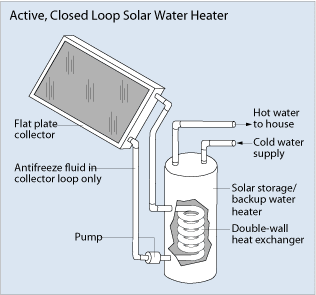"Renewable energy: Any energy resource that is naturally regenerated over a short time scale and derived directly from the sun (such as thermal, photochemical, and photoelectric), indirectly from the sun (such as wind, hydropower, and photosynthetic energy stored in biomass), or from other natural movements and mechanisms of the environment (such as geothermal and tidal energy). Renewable energy does not include energy resources derived from fossil fuels, waste products from fossil sources, or waste products from inorganic sources." - Texas Renewable Energy Industries Alliance
Basically, solar water heaters transform radiation from the sun into heat, and then transfer the heat to water within the system. The main components of the solar water heater are the solar collector and the storage tank.
THE COLLECTOR
The collector carries an absorber which is usually composed of several narrow metal (typically copper or aluminum) strips. The absorber is usually black in colour since dark surfaces display a high light-absorption characteristic. The higher the level of absorption means more of the short-wave solar radiation will be coverted to heat and not reflected. Connected to the metal strips of the absober are heat-conducting pipes, through which the water flows. Once the sunlight heats the absorber to a temperature above the ambient temperature, heat is transferred to the water through the heat conducting pipe.
In order to reduce energy (heat) loss in the absorber through heat emission, the more efficient absorbers are coated with special materials such as black chrome, black nickel and aluminum oxide with nickel. The coating enables the conversion of a high proportion of the solar radiation into heat while, at the same time, reducing the emission of the heat.
The flat-plate collector is probably the most commonly used solar collector. It is simple in design, reliable and relatively inexpensive. It is usually made up of copper tubes attached to the absorber plate. The copper tubes are connected to an inlet and an outlet manifold to enable the wtaer to flow through the copper tubes. This entire assembly is enclosed in an insulated box, covered by glass or clear sun-proof plastic. The transparent cover allows for a great amount of the short-wave light spectrum from the sunlight to enter, while permitting very little of the heat emitted by the abosorber to escape (a greenhouse effect). The cover also prevents the wind from carrying the collected heat away.
Another popular type of collector is the evacuated tube collector. This type has its absorber enclosed in a glass tube. The air in the tube is evacuated to make it highly insulated.
THE STORAGE TANK
The storage tank, which is the other main component in the system, collects and stores hot water until it is needed. The storage tank is well insulated to reduce heat loss by conduction. Some storage tanks come with back-up electric heating elements for use when there is insuffcient solar radiation over a prolonged period. Note that gas water-heaters are also used as back-up.
 ACTIVE AND PASSIVE SYSTEMS
ACTIVE AND PASSIVE SYSTEMS
Solar water heater systems can either be active or passive systems. The difference between active and passive systems is that active systems have circulating pumps and controls for the water flow. Further, active systems can be direct or indirect circulation systems. In the direct circulation system, the water is heated directly by the heat emitted from the absorber. In the indirect circulation systems, however, a non-freezing liquid is pumped through the collector, then a heat-exchanger is employed to transfer the heat from the non-freezing liquid to the water (see picture right). This system is popular in climates with freezing temperature.
Like the active systems, there is more than one type of passive system. The passive system that is commonly used in Guyana is the Thermosyphon System. This system relies on the fact that, in a body of water the warmer sections will rise above the cooler sections. In the Thermosyphon System, the storage tank is placed above the collector, so that warm water automatically and passively rises into tank as it is heated by the collector.
References
- "Solar Collectors: Different Type and Fields of Application," Solar Server, accessed July 16, 2015, http://www.solarserver.com/knowledge/basic-knowledge/solar-collectors.html.
- "Flat-plate Collectors," Your Solar Energy Home, accessed July 16, 2015, http://www.your-solar-energy-home.com/FlatPlateCollectors.html.
- "Active and Passive Solar Water Heating Systems," Rimlife Greentech, accessed July 17, http://www.rimlifegreentech.com/solar_heater_active_passive.htm.

